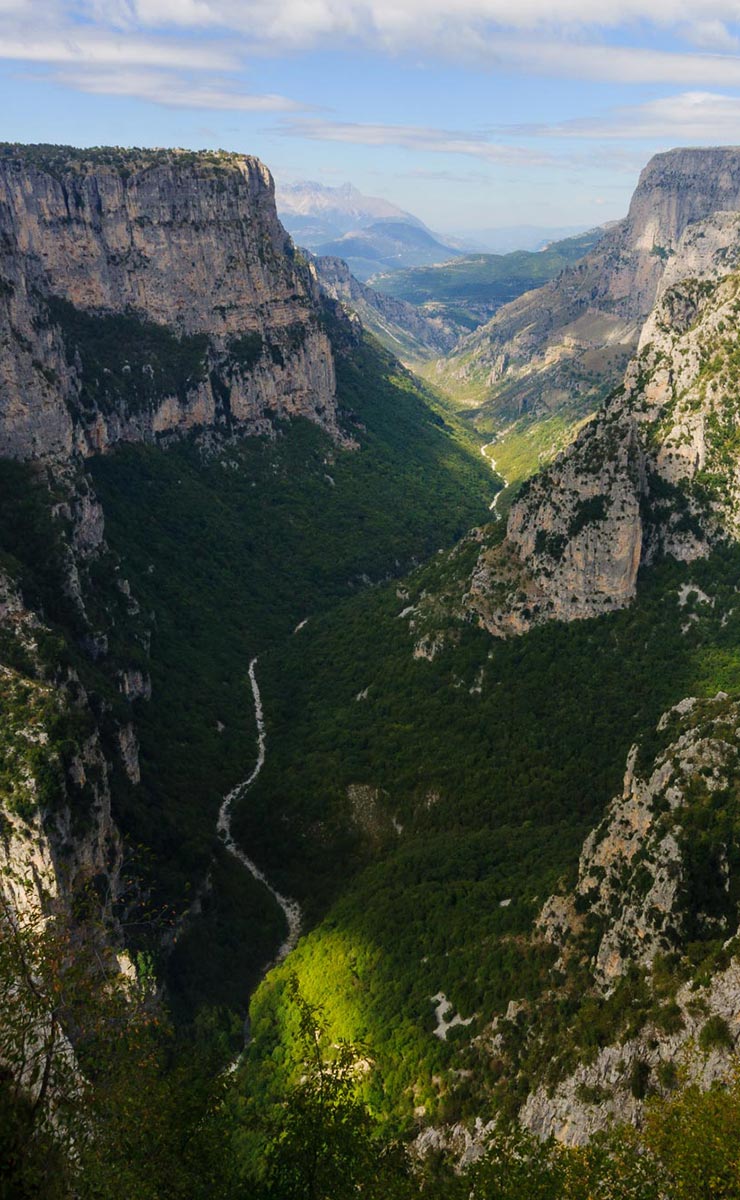What region of Greece is home to the deepest canyon in the world, a village which moved lock, stock and barrel to Corfu to escape Ottoman despotism, and the dramatic, tragic mountaintop site of heroic women and girls dancing off a cliff to their deaths rather than allowing themselves to be abused and enslaved by their attackers?
The answer is Epirus. The main features of this small region of Greece, tucked away in the northwest corner of the country and bordering Albania, is a rugged, mountainous beauty, an alpine climate, and, as always in Greece, beautiful beaches. On the east, the Pindus Mountains, Greece's backbone, separate Epirus from Macedonia and Thessaly. Epirus is well-watered from the prevailing winds out of the Ionian sea to the west bringing abundant rainfall, making it the wettest and greenest region of Greece.
Its biosphere supports a lot of wildlife, including large mammals like foxes, lynxes, deer, wolves and bears. Until the completion of the Egnatia Odos, the chief east-west roadway named after the ancient Roman-built road linking Asia Minor with points west, Epirus was relatively inaccessible and little-visited. During recent years tourism has picked up significantly.
The deepest canyon in the world is the Vikos Gorge, in the Pindus Mountains. Its greatest depth is about 1,000 meters. High above the gorge sits the Agia Paraskevi Monastery, built in the 1400's. It affords a stunning, panoramic view outside, and brilliant frescoes inside.
The village which picked up and moved is Parga, which has a lovely, semicircular harbor on the Ionian Sea, and a remarkably cosmopolitan atmosphere for its population of 12,000. When the British granted Parga to the Ottomans in 1817, rather submit to the hated Turks, Pargans gathered the bones and ashes of their dead and migrated to British-held Corfu, 30 km across the water, and stayed there until Greece's independence from the Ottomans was won in Epirus in 1913.
The event of the women dancing off a cliff is known as the Dance of Zalongo. It took place in 1803 near the village of Kamarina, in southern Epirus, about 25 km north of Preveza. Troops under notorious local Ottoman-Albanian despot Ali Pasha had surrounded a group of Souliot women on a promontory, who, instead of capture, threw their children over the precipice, and followed them, holding hands, singing and dancing. The Souliotes were a fiercely independent mountain people. In a celebrated song commemorating the event, one stanza says that "Fish cannot live on land, flowers on sand, and the women of Souli cannot live without freedom."
Arta is home to a famous, gracefully-arched stone bridge, which legend says was successfully completed only after a bird with a human voice informed the master mason that he had to entomb his wife in one of the pylons. Until then the previous day's work would collapse every night.
Ioannina, with its beautiful lake and island, at 110,000 is the largest city of Epirus. The city is home to 20,000 university students. The monastery on the lake's island was the site of the assassination of Ali Pasha in 1820, whose rule in northern Greece began to threaten that of the Sultan in Istanbul.
Southwest of Ioannina is the ancient oracle of Dodona, perhaps Greece's oldest, dating from as long ago as the Mycenaean Era (1600-1100 BC). It was dedicated to the Mother Goddess Rhea of Gaia.
Besides Parga, other coastal towns of note are Preveza and Igoumenitsa, anchoring the south and north of coastal Epirus, with many points of interest and beaches in between.
Epirus is a fascinating area, for the most part far from the crowds of more touristic areas of Greece, with some areas making you think you are in Switzerland, and others reminding you that you are in Greece, with its clear waters and sandy beaches.












